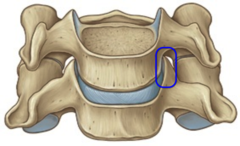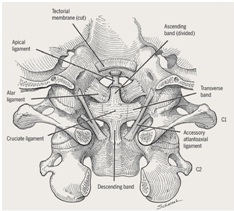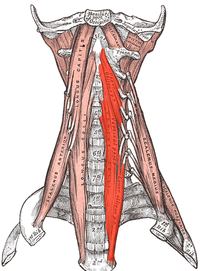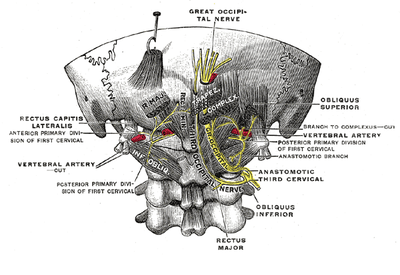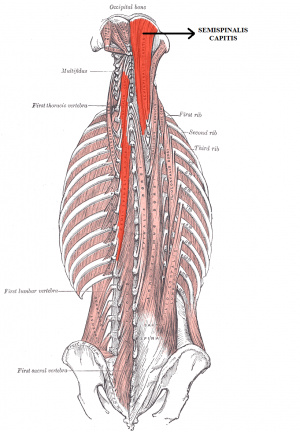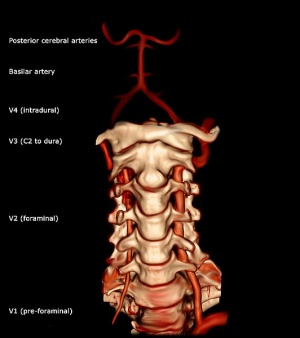Cervical Anatomy: Difference between revisions
No edit summary |
No edit summary |
||
| Line 19: | Line 19: | ||
== Joints == | == Joints == | ||
The joints of the cervical spine can be divided into two groups – those that are present throughout the vertebral column, and those unique to the cervical spine.<ref name=":1" /> | |||
Present throughout Vertebral Column | |||
There are two different joints present throughout the vertebral column: '''The disc joint (determines how much vertebral motion is possible at a particular segmental level), and the facet joints (determine the type of motion)''' | |||
* Disc Joint, between vertebral bodies – adjacent vertebral bodies are joined by [[Intervertebral disc|intervertebral discs]], made of fibrocartilage ([[Joint Classification|cartilaginous joint]], known as a symphysis). '''As a whole, the disc joint itself has three major functions:''' | |||
*# The disc joint bears the weight of the body above it. The increasing size of the vertebral bodies and the discs attached to them descending the spine helps the disc joints bear the increasing weight of the portion of the body above it. | |||
*# The disc joint’s thickness allows for a great deal of motion. Overall, the intervertebral discs comprise 25% of the height of the entire spine. In the cervical spine, they total 40% of its height. The greater the relative height of the discs compared to vertebral body height, the greater the possible motion at that region of the spine. | |||
*# The intervertebral discs help to absorb shock<ref name=":2">Learn muscles . [https://learnmuscles.com/blog/2017/08/01/cervical-spinal-joints/ Cervical spine joints]. Available from: https://learnmuscles.com/blog/2017/08/01/cervical-spinal-joints/ (last accessed 29.1.2020)</ref> | |||
* [[Facet Joints|Facet joint]], formed by the articulation of superior and inferior articular processes from adjacent vertebrae (synovial joint). The scientific name for facet joints is zygapophyseal joints, hence they are also often known as Z joints. Facet joints function to guide motion at that segmental joint level of the spine. F'''acet joints determine the type of motion''' (i.e., the direction of motion) that can occur there. At the upper cervical spine, the plane of the facets is perfectly horizontal in the transverse plane. Descending the cervical spine, the orientation of the facets gradually transition to be more vertical in the frontal plane. As a general rule, the plane of the cervical facets is usually considered to be an oblique plane with an approximately 45-degree angle between the transverse and frontal planes (Fig. 7A). This angle is often compared to that of the slope of a roof. The type of motion best afforded at each vertebral segmental joint level is important to know and understand when performing [[Manual Therapy|joint mobilization]]<ref name=":2" /> | |||
'''Unique to Cervical Spine''' | |||
Joints unique to the cervical spine: uncovertebral joints; the atlanto-axial (x3); atlanto-occipital joints (x2). | |||
[[File:Uncovertebral-joints.png|right|frameless]] | |||
[[Uncovertebral Joints|Uncovertebral]] joints are small synovial articulations, measuring 2 × 4 to 3 × 6 mm., situated between the five lower cervical vertebral bodies. They are located anteromedially to the mixed nerve root and posteromedially to the vertebral artery, vein, and sympathetics as these pass through the vertebral foramen. They participate with the disk and vertebral body in the formation of the anterior wall of the foramen. On the upper surfaces of their posterolateral aspects of the relevant vertebra convex spur-like ridges (consisting of spongy bone and covered by cartilage) are the uncinate process. On the corresponding undersurface of the vertebral body below are concave areas (also covered by cartilage). These two structures come into apposition and are covered by synovial membrane to form the Luschka joints.<ref>RSNA [https://pubs.rsna.org/doi/10.1148/66.2.181 Joints of Luschka] Available from: https://pubs.rsna.org/doi/10.1148/66.2.181 (last accessed 28.1.2020)</ref> | |||
The [[Atlanto-axial joint|atlanto-axial joints]] are formed by the articulation between the atlas and the axis: | |||
* Lateral atlanto-axial joints (x2) – formed by the articulation between the inferior facets of the lateral masses of C1 and the superior facets of C2. These are plane type synovial joints. | |||
* Medial atlanto-axial joint – formed by the articulation of the dens of C2 with the articular facet of C1. This is a pivot type synovial joint. | |||
The [[Atlanto-occipital joint|atlanto-occipital joints]] consist of an articulation between the spine and the cranium. They occur between then superior facets of the lateral masses of the atlas and the occipital condyles at the base of the cranium. These are condyloid type synovial joints, and permit flexion at the head i.e. nodding. | |||
== Ligaments == | == Ligaments == | ||
Revision as of 07:12, 29 January 2020
This article or area is currently under construction and may only be partially complete. Please come back soon to see the finished work! (29/01/2020)
Original Editor - Your name will be added here if you created the original content for this page.
Top Contributors - Lucinda hampton, Manisha Shrestha, Kim Jackson, Robin Tacchetti and Abbey Wright
Introduction[edit | edit source]
An expert understanding of cervical anatomy is critical to physiotherapists working in this region. An understanding of this anatomy is essential for assessment and treatment of cervical spine problems. This page is a review of cervical spine osteology, ligaments, muscles, and neurovascular structures.
The cervical spine, comprised of seven cervical vertebrae referred to as C1 to C7, is divided into two major segments: the craniocervical junction (CCJ) and the subaxial spine. The CCJ includes the occiput and the two most cranial cervical vertebrae known as the atlas (C1) and the axis (C2). The subaxial spine includes the five most caudal cervical vertebrae (C3-C5).[1] The cervical spine’s major functions include supporting and cushioning loads to the head/neck while allowing for rotation, and protecting the spinal cord extending from the brain.[2]
Vertebrae[edit | edit source]
Intervertebral Disc[edit | edit source]
Joints[edit | edit source]
The joints of the cervical spine can be divided into two groups – those that are present throughout the vertebral column, and those unique to the cervical spine.[3]
Present throughout Vertebral Column
There are two different joints present throughout the vertebral column: The disc joint (determines how much vertebral motion is possible at a particular segmental level), and the facet joints (determine the type of motion)
- Disc Joint, between vertebral bodies – adjacent vertebral bodies are joined by intervertebral discs, made of fibrocartilage (cartilaginous joint, known as a symphysis). As a whole, the disc joint itself has three major functions:
- The disc joint bears the weight of the body above it. The increasing size of the vertebral bodies and the discs attached to them descending the spine helps the disc joints bear the increasing weight of the portion of the body above it.
- The disc joint’s thickness allows for a great deal of motion. Overall, the intervertebral discs comprise 25% of the height of the entire spine. In the cervical spine, they total 40% of its height. The greater the relative height of the discs compared to vertebral body height, the greater the possible motion at that region of the spine.
- The intervertebral discs help to absorb shock[4]
- Facet joint, formed by the articulation of superior and inferior articular processes from adjacent vertebrae (synovial joint). The scientific name for facet joints is zygapophyseal joints, hence they are also often known as Z joints. Facet joints function to guide motion at that segmental joint level of the spine. Facet joints determine the type of motion (i.e., the direction of motion) that can occur there. At the upper cervical spine, the plane of the facets is perfectly horizontal in the transverse plane. Descending the cervical spine, the orientation of the facets gradually transition to be more vertical in the frontal plane. As a general rule, the plane of the cervical facets is usually considered to be an oblique plane with an approximately 45-degree angle between the transverse and frontal planes (Fig. 7A). This angle is often compared to that of the slope of a roof. The type of motion best afforded at each vertebral segmental joint level is important to know and understand when performing joint mobilization[4]
Unique to Cervical Spine
Joints unique to the cervical spine: uncovertebral joints; the atlanto-axial (x3); atlanto-occipital joints (x2).
Uncovertebral joints are small synovial articulations, measuring 2 × 4 to 3 × 6 mm., situated between the five lower cervical vertebral bodies. They are located anteromedially to the mixed nerve root and posteromedially to the vertebral artery, vein, and sympathetics as these pass through the vertebral foramen. They participate with the disk and vertebral body in the formation of the anterior wall of the foramen. On the upper surfaces of their posterolateral aspects of the relevant vertebra convex spur-like ridges (consisting of spongy bone and covered by cartilage) are the uncinate process. On the corresponding undersurface of the vertebral body below are concave areas (also covered by cartilage). These two structures come into apposition and are covered by synovial membrane to form the Luschka joints.[5]
The atlanto-axial joints are formed by the articulation between the atlas and the axis:
- Lateral atlanto-axial joints (x2) – formed by the articulation between the inferior facets of the lateral masses of C1 and the superior facets of C2. These are plane type synovial joints.
- Medial atlanto-axial joint – formed by the articulation of the dens of C2 with the articular facet of C1. This is a pivot type synovial joint.
The atlanto-occipital joints consist of an articulation between the spine and the cranium. They occur between then superior facets of the lateral masses of the atlas and the occipital condyles at the base of the cranium. These are condyloid type synovial joints, and permit flexion at the head i.e. nodding.
Ligaments[edit | edit source]
There are six major ligaments to consider in the cervical spine. The majority of these ligaments are present throughout the entire vertebral column.
Present throughout Vertebral Column
- Anterior and posterior longitudinal ligaments – long ligaments that run the length of the vertebral column, covering the vertebral bodies and intervertebral discs.
- Ligamentum flavum – connects the laminae of adjacent vertebrae.
- Interspinous ligament – connects the spinous processes of adjacent vertebrae.
Unique to Cervical Spine
- Nuchal ligament – a continuation of the supraspinous ligament. It attaches to the tips of the spinous processes from C1-C7, and provides the proximal attachment for the rhomboids and trapezius.
- Transverse ligament of the atlas – connects the lateral masses of the atlas, and in doing so anchors the dens in place.
(Note: Some texts consider the interspinous ligament to be part of the nuchal ligament).[3]
Muscles[edit | edit source]
The cervical vertebrae serve as the origination and insertion points for a host of muscles that support but also enable movement of the head and neck. The musculature of the neck is comprised of a number of different muscle groups. They can be divided into anterior, lateral and posterior groups based on their position in the neck. They are further divided into more specific groups based on a number of determinants; including depth, precise location, and function.
1.Anterior neck muscles
Superficial muscles - platysma, sternocleidomastoid, subclavius
Suprahyoids - digastric, mylohyoid, geniohyoid, stylohyoid
Infrahyoids - sternohyoid, sternothyroid, thyrohyoid, omohyoid
Scalenes - anterior, middle and posterior scalene muscles
2.Lateral (prevertebral) neck muscles
Rectus capitis, Longus capitis, Longus colli
3.Posterior neck muscles
Superficial muscles - splenius capitis, splenius cervicis
Suboccipital muscles - rectus capitis posterior major, rectus capitis posterior minor, obliquus capitis inferior, obliquus capitis superior
Transversospinalis muscles - semispinalis capitis, semispinalis cervicis, rotatores cervicis, interspinales, intertransversarii.[6]
Blood Supply[edit | edit source]
Distal to their bifurcation from the subclavian arteries, the vertebral arteries course cranially to the base of the skull. They progress past the C7 vertebrae anteriorly before entering the transverse foramen of C6. After exiting the C2 transverse foramen, the arteries bend laterally to enter the more widely placed transverse foramen of C1 and then revert medially over the superior aspect of the arch of the atlas before entering the base of the skull. Main tributaries of the vertebral arteries, the cervical radicular arteries, supply blood directly to the cervical vertebral bodies.
Also located in the cervical spine region are the carotid arteries. The common carotids bifurcate into the internal and external carotids at the C3 vertebral level. Despite their association with the neck, they do not perfuse any structures in the cervical spine.[1]
Nerves[edit | edit source]
The cervical spine functions as bony protection of the spinal cord as it exits the cranium.
Despite the presence of seven cervical vertebrae, there are eight pairs of cervical nerves, termed C1 to C8. C1 through C7 exit the spine cranially to its associated vertebrae, while C8 exits caudally to C7. [1]
The transverse foramina of the cervical vertebrae provide a passageway by which the vertebral artery, vein and sympathetic nerves can pass. The only exception to this is C7 – where the vertebral artery passes around the vertebra, instead of through the transverse foramen.[3]
References[edit | edit source]
- ↑ 1.0 1.1 1.2 Kaiser JT, Lugo-Pico JG. Anatomy, Head and Neck, Cervical Vertebrae. Available from: https://www.ncbi.nlm.nih.gov/books/NBK539734/ (last accessed 28.1.2020)
- ↑ Frost BA, Camarero-Espinosa S, Foster EJ. Materials for the spine: anatomy, problems, and solutions. Materials. 2019 Jan;12(2):253. Available from:https://www.ncbi.nlm.nih.gov/pmc/articles/PMC6356370/ (last accessed 28.1.2020)
- ↑ 3.0 3.1 3.2 Teach me anatomy The cervical Spine Available from:https://teachmeanatomy.info/neck/bones/cervical-spine/ (last accessed 28.1.2020)
- ↑ 4.0 4.1 Learn muscles . Cervical spine joints. Available from: https://learnmuscles.com/blog/2017/08/01/cervical-spinal-joints/ (last accessed 29.1.2020)
- ↑ RSNA Joints of Luschka Available from: https://pubs.rsna.org/doi/10.1148/66.2.181 (last accessed 28.1.2020)
- ↑ Ken Hub Muscles of the neck Available from: https://www.kenhub.com/en/library/anatomy/muscles-of-the-neck-an-overview (last accessed 28.1.2020)
